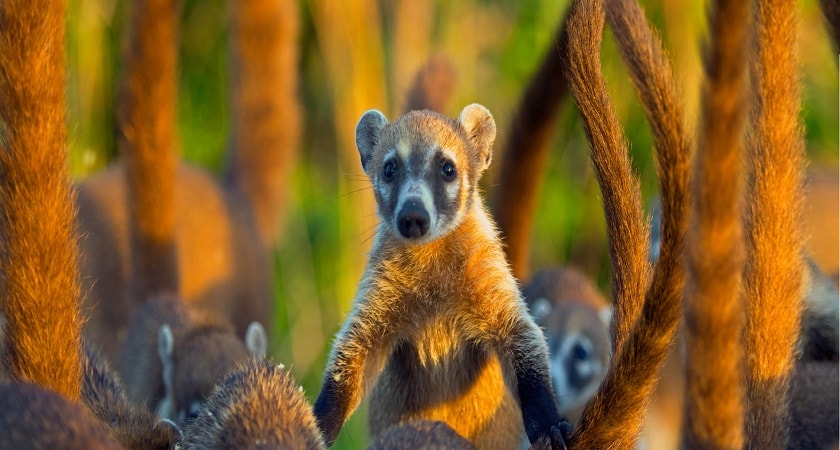The coatis are medium-sized mammals, which live in different habitats of the south, central, and North America. Coatis eat different types of insects, rodents, reptiles, fruits, and nuts. The scientific name of the coati is Nasua and belongs to the family Procyonidae.
They are often called coatimundi or coatimundi and are closely related to the raccoons. They are found in tropical regions of South America, from Colombia and Venezuela to Uruguay, as well as in northern parts of Argentina.

Their long snout gives them the name hog-nosed raccoons. They have a slender head with small ears which helps them to hear from a distance and act accordingly if some predator is nearby. Their coarse fur can be grey to reddish or brown with a lighter under-part.
Their long tail can be equal to their body size which helps them balance. The color of the tail is usually brown with rings on it and rings go completely around the tail. Also, one interesting fact is, that they are found only on the American continent.
Taxonomy Of Coatis according to ITIS
An adult coati can be 33 to 70 cm (without tail) long, 32 cm tall, and weigh around 10 to 24 pounds. Females are found comparatively smaller than males. The group of female coatis is called a band. Females and young coatis live in bands or groups of 5 to 30, while males are solitary so they live and survive on their own.
What do coatis eat?
Coatis are omnivorous which means they eat a variety of food. They are a mammal. Their diet is mainly comprised of fruits and invertebrates. Coatis eat scorpions, centipedes, spiders, ants, termites, lizards, small mammals, rodents, palms, eggs, and different types of fruits and vegetables as well.

Coatis are nocturnal, which are arched during the moonlight and sleep in the daytime. The long snout with the nose is amazing to sense the food and the paws are capable to unearth invertebrates. Because of having small size, they have a large number of predators in the wild and the environment where they live.
Their main predators are jaguars, pumas, and other large wild cats. Coatis are smart and opportunistic feeders, finding food is really not a big challenge for them, but saving themselves from predators is a difficult task. Coati’s diet is really strict and most of the portion of their food consists of small rodents and insects. A variety of different fruits like barriers, sweet potatoes, pomegranate, and winter squash are also eaten by them. Besides that, Catching squirrels is really common for them and it’s easily available food.
Coatis are opportunists they really have a great sense of smell. They sniff out all kinds of insects and bugs. They are highly social animals. Coatis live in various habitats like dense jungles, grasslands, wet jungles, mountains, and deserts. They are omnivores so can switch their diet accordingly. Coatis are smart and know how to survive in a different environment. They can eat a vast range of food that includes meaty and leafy varieties.
The species of coatis:
The ring-tailed coati:

It has tan-colored thick fur and black bands along its tail. The ring-tailed coatis inhabit the rainforest and jungles of South America. They eat different kinds
The Mountain Coati:

The mountain coati is the smallest coati species also called the dwarf coati. They have a body length between 36 and 39 cm and their weight is counted around 1.3 kg. They inhabit the Andes mountain range of South America. The mountain coatis eat small rodents, reptiles, fruits, and bugs.
The white-nosed coati:

The white-nosed coati is the largest coati species. The size of a young white-nosed coati may reach up to 120 cm in length and weigh around 4 to 6 kg. They are found throughout North and Central America. They prefer eating small vertebrates, fruits, carrions, insects, snakes, and eggs.
The CozIslandsland coati:

This species of coati is only found in Cozumel Island of Mexico. It is treated as a subspecies of white-nosed coati and shares a lot of the same traits. Cozumel Island coatis are slightly smaller than the white-nosed coatis.
Offspring:
Only one male is accepted to a band. The mating season starts between January and March in some locations and between October and February in others. It varies with the location and availability of food. They generally mate during the start of the rainy season. After mating, the male leaves and goes back to live solitarily, on the other hand, the female builds the nest. Nests are made by females on the rocky edge or on trees. The male coatis join the group only when the mating season starts and they remain with the band for a month.

The gestation period remains around 75 to 78 days and the female gives birth to 3 to 7 young coati. The baby coat was born between April and June. They are born on treetop nests made by the female. In 19 days, young Coatis can stand and rejoin the band. Although, Within 24 to 26 days, they are able to walk. They start eating solid food at the age of 3 to 4 months and females. The mother keeps the search for food at night to feed the young children. Males become mature at the age of three years, while females are considered mature at the age of two years. A coati can live 7 to 8 years in the wild while it may live around 17 to 18 months in captivity.
Are coatis dangerous?

Coatis are not so dangerous and can be kept as a household pet as well. The white-nosed and South American coatis are common in captivity. Besides that, mountain coatis are extremely rare to be kept as a pet. They are neither so friendly so it’s kind of difficult to train them to behave according to humans. Keeping a coati as a pet requires so much time and care. Their diet is a little varied and the food that coatis eat is different than other pets. Having a coati pet can be a good idea provided that you have a lot of time to care for one.
Coatis are really attractive and smart animals…have you seen them?….share your experience with us or let us know if this article is helpful and informative for you, below in the comment section…

 T-Shirts
T-Shirts Long Sleeves
Long Sleeves Hoodies
Hoodies Sweatshirts
Sweatshirts

 Baby Bodysuits
Baby Bodysuits
 Cap
Cap

